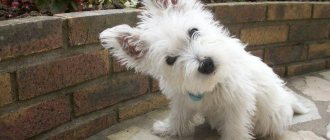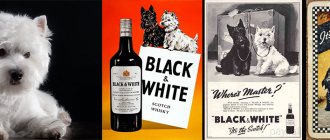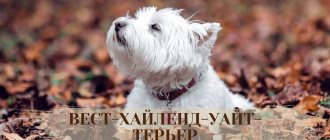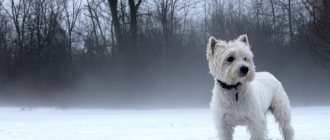The West Highland White Terrier is a breed of hunting dog developed in Scotland. It is quite ancient and has long been used for hunting small burrowing animals. Despite its small size, this dog is active, efficient and courageous. She is now popular as a companion due to her peaceful nature and cheerful disposition. Before getting a West Highland White Terrier, it is worth studying the description of the breed and a video about it. Reviews from the owners will help you learn about its character, pros and cons of its content.
- Head
- Education and training
- Grooming
Description of the West Highland White Terrier breed
Popularity 216th place among 263 dog breeds
Lifespan:
12-16 years old
Breed group:
Decorative
Height:
males: 25-30 cm, females: 23-28 cm
Country of origin:
Scotland
Average price:
30-40 thousand rubles
Weight:
males: 7-10 kg, females: 6-7 kg
Latest articles Cat health
Rabies vaccination for cats: choice of vaccine, necessity, schedule 01/22/2022 4 0 0
Selection and adaptation
TOP 20 best cat breeds for families with children 01/22/2022 25 0 0
Main physical characteristics of the breed:
- dog height – up to 28 centimeters;
- weight – 6-10 kg;
- life span – about 15 years;
- the coat is white, thick up to 5 cm long, straight, with a soft undercoat;
- the head is rounded, covered with thick hair;
- nose – black, relatively large;
- eyes – black, medium size with a piercing gaze, covered with fur,
- the neck is muscular, rather long;
- jaws – strong with correct bite of large teeth;
- the body is compact, the back is flat;
- the physique is strong;
- tail set high, not docked;
- paws are short and muscular;
- physically resilient.
Key facts
The West Highland White Terrier is a mischievous fidget with a shaggy white coat. Descriptions of the West Highland White Terrier breed were found back in the Middle Ages.
The homeland of dogs is called the areas of western Scotland, completely covered with rocks and mountains. It was in such conditions that the dog was able to demonstrate and develop his working abilities.
Sociable and very energetic representatives of the breed get along well with all family members, but only one person is recognized as the owner. Unlike other individuals of the terrier group, they get along well with other pets. Characteristics of the West Highland White Terrier breed indicate their keen intelligence, curiosity and desire to dominate.
Due to their small size, dogs feel comfortable in a city apartment or a country house. The lifespan of a West Highland White Terrier ranges from 12 to 16 years. There are other names for representatives of the breed - Westie (Westi), white highland terrier.
Health
The White Terrier is generally a strong, hardy, healthy breed. Westies live up to 12 years, and some dogs reach their 18th birthday.
However, the breed is characterized by a number of diseases. They significantly affect life expectancy. Among the possible pathologies:
- pulmonary fibrosis due to colds, hypothermia;
- dermatitis;
- allergy;
- cataract;
- conjunctivitis;
- type 2 diabetes;
- ichthyosis;
- joint dysplasia;
- deafness;
- meningoencephalitis;
- cardiomyopathy;
Congenital heart defects characteristic of the breed are hypertrophy of the ventricle or interventricular septum.
History of the origin of the West Highland White Terrier
The Highland Terrier is a breed developed in western Scotland. It is considered so ancient that its origins go back to medieval sources.
Initially, the terrier was used to hunt wild animals living in burrows: badgers, foxes, and other predators. Some of them were larger than the Westies. It has been suggested that the ancestors of the highland individual were Cairn Terriers and Scotch Terriers originally from England.
Interestingly, dogs originally had limitless color options. Pets could be fawn or brindle. But puppies with a white color were considered a waste at that time because they were too painful. Owners almost always got rid of such babies.
Much later, in the 19th century, the breed standard was determined. It was proposed by Colonel Edward Malcolm of Poltalok and Duke of Argyll George Campbell. They preferred the white-haired representatives.
At that time, the usual name for the breed did not yet exist, so the colonel’s pets were called Poltalloch Terriers, and the Duke’s individuals were called Rosenet Terriers.
The first official club of Westie lovers appeared in 1904 in Scotland. It was founded by the descendants of the Duke of Campbell. Three years later, a nursery for breeding snow-white individuals was opened there.
It was then, after performing at an exhibition in London, that the dog became very popular. Breeders were attracted by the sociable disposition, good adaptability and excellent working qualities of miniature individuals. One of the main characteristics of the breed was its white color, which was recognized as the most convenient during hunting in the field. In this case, people did not confuse their assistant with foxes or other predators.
How to choose a puppy
Puppies can be given into the wrong hands no earlier than at the age of eight weeks. By this time, he had received his first vaccination and measures were taken to protect him from worms. He already feeds on his own and is in the so-called formation stage, which allows him to easily adapt to new conditions and get used to new people.
Arrange a meeting with several dog handlers, without making a promise to buy a puppy. You will very quickly see where the dogs have a really good bond with their owner, where the puppies are sociable and friendly towards people. Be patient and don’t get excited when you see the first funny puppy you see. Think critically about your future purchase and make sure you make the right choice before making it. If you make a rash purchase, you will have to regret your haste throughout the dog’s life.
Similar dog breeds
Pomeranian Spitz
Jack Russell Terrier
Scottish Terrier
Yorkshire Terrier
Bichon Frize
Appearance of the West Highland White Terrier
General impression
Westie is a miniature snow-white dog with curious, beady eyes. To some, the photo of a West Highland White Terrier resembles a plush toy with a large head and a cute tail that looks very much like a carrot.
Unlike other miniature animals, Westies have strong bones, so the owner does not have to constantly monitor the pet’s movements and protect it from jumping. Fractures are not scary for the baby.
Head
The skull of the Snow White Terrier has a wide shape. The front part is somewhat convex, with prominent brow ridges. The stop is clearly pronounced.
Despite its miniature size, the Westie has a powerful jaw. The terrier has a full, scissor bite. The teeth are straight and large. The eyes are deep-set and almond-shaped. The color of the iris is always dark.
The nose does not protrude beyond the muzzle and has a large black lobe. During the cold season, the lobe may become slightly lighter due to lack of sunlight.
The dog's ears are located close to each other. They are small, pointed in shape, and covered with velvety wool on the outside.
Neck
The cervical region is quite long and covered with strong muscles. Towards the body, this part gradually thickens and becomes more massive.
Torso
The body of the white highland terrier is compact in size. However, the skeleton is powerful, and the entire body is covered with strong muscles. The dog's chest is deep and wide. The back area is absolutely straight, with a strong loin and widened croup. The underline is smooth and lean.
Front and hind limbs
The front legs of the West Highland White Terrier are straight and short, with well-developed muscles. Sometimes the forelimbs are slightly turned out. This is explained by genetic characteristics - the ancestors of terriers dug the ground, throwing the earth in different directions, which gradually led to an easy spreading of the limbs.
The Westie's hind legs have a muscular and wide upper part. The limbs themselves are short and sinewy. The toes on all four paws are tightly pressed together. The pads are plump and dark in color.
Tail
The West Highland White Terrier has a medium sized tail. It is located perpendicular to the body, and during movement it is almost vertical. It is prohibited to buy it.
Movements
These little hunters are very mobile and can cover long distances. They run fast and are able to jump over fairly high obstacles. When moving, West Highland White Terriers place their paws parallel to each other, pushing off powerfully from the ground.
Wool
The animal's coat is hard, without fringe, with a thick soft undercoat. The length of the hair reaches 5 cm. The hard guard type of coat helps to get through the thorns without damaging the skin.
In the area of the back and tail the hair is shorter. The longest fur is on the belly. On the paws and face the hair curls in curls. The coat grows completely by the age of three.
Color
The colors of the West Highland White Terrier are the same. All modern representatives of the breed must be only white: without spots or dusting. Other options will be considered a deviation from the standards.
Dimensions
Despite the fact that the size of the West Highland White Terrier is small, the dog is a strong and stocky breed. The weight of the West Highland White Terrier reaches 10 kg. The size of males is larger than that of females. The height of the West Highland White Terrier reaches 28 cm.
Character and temperament
The Westie is a typical representative of the terrier group. His instincts constantly “speak” to him - he loves to bark, dig in the ground and does this with perfect tenacity. The West Highland is full of energy, which it will happily spend with its owner.
Positive sides:
- funny;
- confident;
- smart;
- brave;
- friendly.
Negative features:
- loves to bark;
- narcissistic;
- stubborn;
- impatient.
Character of the West Highland White Terrier
Domesticated hunters are distinguished by their stubborn character, courage and cheerful disposition. It is necessary to carry out training and socialization of Westies from a very early age. Only in this case does the puppy grow into a well-mannered companion dog.
The West Highland White Terrier is good with children and enjoys playing with them. However, it is not worth buying representatives of the hunting breed for families with preschool children. Pets are not known for their loyalty to children and do not tolerate annoying pestering. Because of this, there will definitely not be a good relationship between them.
West Highland White Terrier dogs show great devotion and affection to their owners. The terrier recognizes only one family member as its owner.
Westie is also very jealous. She will not want to share the attention of her loved one with another pet. The Snow White Terrier loves to fight, and the size of the opponent is not important to him.
Dogs cannot stand loneliness, although they can easily entertain themselves. They really love to misbehave. The genes of their ancestors have been preserved in them, so West Highland White Terriers dig trenches during walks in search of wild animals. And when they find a mouse or other small rodent, they immediately rush into battle.
The nature of the West Highland White Terrier shows that they serve as excellent companions to their owners, but are also capable of acting as guards. Dogs have very good sense of smell and hearing, and they can bark loudly. Westies do not experience any particular hostility towards strangers, but in case of danger they will boldly rush at the enemy.
Pets are highly active and very curious, so they are ideal for lovers of active sports or adherents of a healthy lifestyle.
Suitable nicknames for Westies
The nicknames for West Highlands are special. These are just white and fluffy dogs. In fact, they have a noble, brave, somewhat capricious character. Therefore, ordinary names for small breeds will not be suitable for Westies.
Breeders themselves choose the names for the puppies - for each litter they begin with the same letter and contain a prefix with the name of the kennel. But they are long and awkward to pronounce. Therefore, kittens are often baptized at home - by shortening the nickname from the pedigree or inventing their own.
| Names suitable for boys | Nicknames for girls |
| Zeus | Bernie |
| One | Valkyra |
| Tim | Xena |
| Brock | Moran |
| Hercules | Esmeralda |
| Tank | Alva |
| Jed | Sheila |
| Kurt | Lorita |
| Asterix | Cecile |
| Daron | Mirli |
| Shelby | Regina |
| Ralph | Scarlett |
| White | Iris |
| Leon | Ashley |
| Prometheus | Ariel |
| Cody | Laura |
| Gabi | Carol |
| Dean | Nola |
| Badi | Verna |
Education and training
In order for the Snow White Terrier to become a fully socialized friend, its training must begin immediately after meeting a new family. Raising and training a West Highland White Terrier can only be carried out by a person who has confirmed his authority. A wayward animal will not follow the commands of one it considers stupider than itself.
The dog will not work even at the insistence of the owner. The dog must be stimulated and encouraged to successfully fulfill the requirements. Training and training a Westie is not complete without dog treats and praise. To prevent your pet from getting bored, you will have to take play breaks. They will help the terrier to pamper himself and further concentrate on the trainer’s tasks.
It is important for the owner and family members to stop the puppy’s attempts to bite the hands or feet of a person from childhood. This way the pet will try out its hunting skills. At these moments, you need to switch the naughty boy’s attention to toys.
Before you start walking your Westie puppy outside, he should be accustomed to a leash and collar. In addition, before starting basic training, the pet must be able to:
- respond to the owner’s voice the first time;
- find out your nickname;
- respond appropriately to the appearance of other animals.
It is recommended to work on commands in special areas after the puppy is 9-10 months old. The owner himself can train the dog, or he can enroll a friend in a kennel club. There, the Westie will select a program that suits his age and requirements and help him correct his behavior.
When living together with a West Highland White Terrier, it is important to ensure that he adheres to basic standards of behavior. Representatives of this breed very quickly see a person’s weaknesses and take advantage of them with pleasure.
So, you should not allow the animal to lie on the bed and ask for tidbits from the plate of family members. If you give in to your pet several times, you will not be able to comply with the rules in the future.
Key points in training
In order for West to obey, the owner needs to prove his authority and teach the dog that the person is in charge. Only then will the terrier become obedient and follow all commands. They are easy to learn, but do not tolerate harsh treatment. They will be happy to train for food. The best training is agility for medium dogs (obstacle course).
From the moment the puppy arrives in the house, it is necessary to accustom him to places for sleeping and feeding. You need to talk to your pet and call him by name. When the dog begins to respond to its name, you can begin to learn the commands:
- "Near";
- "Place";
- "Sit";
- "Voice";
- "Quiet".
- Read about how to properly train a dog in the article: “Training a puppy: effective methods from dog handlers, learning commands at home.”
Health and Diseases of the West Highland White Terrier
Possible diseases
Unlike many other relatives of the terrier group, West Highland Whites are considered quite healthy individuals. This is indicated by their life expectancy: with proper care and maintenance, Westies can delight their owners for 12-16 years.
However, there are diseases that occur in white hunters:
- congenital deafness;
- diseases of the cardiovascular system;
- diabetes mellitus of various types;
- age-related eye cataracts;
- meningoencephalitis of white dogs;
- ichthyosis;
- hip dysplasia.
Timely visits to a veterinarian and regular vaccinations will help prevent illnesses or reduce their consequences. We must not forget about medications for intestinal parasites, which are given to pets 2-3 times a year. The wool is treated quarterly to remove skin insects.
Reproductive health
Final puberty in females occurs by one and a half years of age. At this time, the third estrus begins in females.
Mating is carried out on the 10-15th day of estrus. Early mating of a bitch is not recommended, because in this case the animal is not able to give birth to healthy offspring. It is wiser to carry out mating on the male’s territory to ensure the groom’s peace of mind and create comfortable conditions.
It is recommended that West Highland White Terriers be spayed before they are one year old, so that the surgical procedure can be carried out with the least possible consequences for the female’s health.
Mating
This breed is quite rare; most often the mating is for breeding and official purposes. Puppies reach puberty at 8-10 months: bitches begin to go into heat, and males begin mating. But you can only knit by 20 months . The most optimal time is 13-15 days from the start of the girl’s estrus.
Signs of a female's readiness:
- Swollen loop;
- Light discharge;
- Playful behavior.
The dogs are first introduced and walked together the day before mating. At the appointed time, the girl is brought to the dog’s territory, where the act should take place. It will last no more than 20 minutes , but pets can stay in the castle for a long time. It is important to choose a comfortable position for the animals in which they cannot be injured.
For the first time, it is customary to invite a specialist who will tell the owners what to do, guide the dogs and help them. Before mating, it is necessary to check pets for pathologies and carry out a deworming procedure.
Features of feeding and diet
The White Highland Terrier's menu should be varied and balanced. The basis of nutrition should be protein foods. But we should not forget about the introduction of complex carbohydrates and fats into food, which are necessary to maintain a Westie in a healthy state.
The owner must decide what type of food to use. Westie responds well to both natural food and industrial feed. The latter type can cause digestive problems, so the product should only be premium or holistic.
The advantages of high-quality industrial feeds are their complete balance. They contain vitamin and mineral complexes necessary for the proper development of the four-legged prankster. In addition, the owner does not have to spend time preparing food for the pet every day.
It is important to balance natural food. This means that more than half of the menu consists of lean meats: rabbit, chicken, beef and lamb. When adding vegetables and fruits to the menu, they must be boiled and chopped - or finely grated fresh. Among cereals, preference should be given to buckwheat, rice and oatmeal.
You cannot give news:
- sweets;
- flour products;
- tubular types of bones;
- fish with bones;
- legumes
It is necessary to ensure that the animal has constant access to drinking water for any type of food. It is optimal to install an automatic drinker - or change the water yourself several times a day.
From 1 month, puppies begin to be given complementary foods. These can be low-fat fermented milk products, cottage cheese, boiled yolks, liquid viscous porridge. You cannot overfeed Westies or treat them with pieces from the owner's table. This can cause obesity and lead to food allergies.
Care and maintenance
The small size of the Westie makes it possible to maintain it in any type of housing: from a small city apartment to a large country house. The pet's habitat should be located away from drafts and provided with toys so that it can entertain itself while the owner is at work or busy with something. For representatives of this breed, a tray with filling and a bowl of water for drinking are placed near the lounger.
One of the main conditions for keeping and caring for a West Highland White Terrier is frequent and long walks. It is convenient if the dog has his own area for walking in the yard. However, if you leave the animal to its own devices, then digging holes in the area and damaging the flower beds is inevitable. In the city, a Westie needs to spend time on sports grounds and participate in active games with the owner.
The coat of doggies needs special attention and care. The pet should be brushed daily with a wire brush. This procedure will help remove dirt, remove dead hair and improve the condition of the skin.
Snow White Terriers are a wire-haired breed of dog, so they practically do not shed. Because of this, there is a need to regularly visit salons for trimming. The master will remove all old and thinning hairs, giving the opportunity to grow new and strong. Trimming is carried out at least twice a year.
In addition, representatives of the West Highland White Terrier breed need timely hair trimming, nail care, and weekly ear and teeth cleaning. Improper care of your pet leads to the formation of tangles on the body, the appearance of skin parasites, allergies and fungal infections.
It is recommended to carry out water procedures for Westies no more than 3-4 times a year, depending on the degree of contamination of the white fur. After walking in the fresh air, it is enough for the terrier to wash his paws. Westies are very clean and do not emit a specific smell around them.
Application
The West Highland can still go hunting with you.
You can read about other hunting breeds here:
Sensitive hearing and a ringing voice make the West an excellent watchman - he will immediately inform you of any incident with a loud bark.
With Westies you can engage in active types of dog sports, keep him just “for fun” and for long walks in good company.
Westies make good hunters
Tips for choosing a puppy
To purchase a pet, it is better to contact breeders registered in the RKF, who carry out matings in compliance with all the rules. It is best to find out all the breed standards yourself before choosing West Highland White Terrier puppies. Then there will be no problems with determining the purebred of the animal.
The temperament and intelligence of puppies is not affected by their gender. Although lovers of the breed talk about the better trainability of males.
The purchased puppy must look healthy, its fur must be shiny and clean. You should carefully examine the baby's eyes and ears - any type of discharge is unacceptable.
The baby should be active, inquisitive, not afraid of people and good at making contact. A conscientious breeder, upon the first request of the buyer, shows the pedigree of the parents and veterinary documents of the offspring.
Disqualifying faults
The West Highland White Terrier dog breed is removed from the ring for any defects in appearance that significantly deviate from the standard. Among the possible defects:
- barrel ribs;
- X-shaped position of the limbs;
- wool with waves or curls;
- long (swan) or short (bull) neck;
- feathering, fringe on the ears or tail.
All these shortcomings affect the assessment. Whether to disqualify a pet is decided based on the severity of the defect and its effect on the dog’s physical health.
Serious behavioral shortcomings - cowardice, aggression. Pets are culled for them.










